Rethinking the Voice of the Migrant Worker
With her Taiwanese-Filipina roots, Rina B. Tsou cleverly brings to light the intricate issues pertaining to the liminal space between home and the foreign land, as outlined in Arnie, the story of a Filipino seaman who deals with feelings of alienation and despair while working in Taiwan. Due to his long absence from home, Arnie finds himself trapped within the space between the familiar and the foreign, belonging to neither, his home in the Philippines, nor Taiwan, the place of his work. The film sheds light on the struggles that the migrant worker faces, where their very absence from home traps them further into their isolation. Everyone and everything at home is constantly changing, while they, being miles apart, remain stagnant and excluded from that process of movement that occurs back home.
For starters, Tsou’s usage of the handheld camera aptly situates spectators in Arnie’s world, where he works on a ship and is constantly on the move. But on a deeper level, it mirrors the sense of displacement that Arnie, the migrant worker in a foreign land, feels. However, the subject of the migrant worker is not new to many of us, especially within the Singaporean context where foreign labour is a widely discussed topic. Nonetheless, what makes Tsou’s film particularly interesting is the ambiguity in the relationship between Arnie and the foreign land, where the deliberate rejection of closure between characters adds a layer of complexity to these issues that we are all too familiar with.
Throughout the film, the relationship between Arnie and the foreign land remains ambiguous. The space of the foreign land is personified by Emily Chen, a young Taiwanese woman from Arnie’s agency. She encapsulates everything that is foreign to Arnie; not only is she of a different race and gender, but her identity as the agency liaison already puts forth a certain amount of detachment between herself and the Filipino seamen. However, despite the two characters belonging to different places within society, their relationship is one that hinges upon intimacy. The first time we see them in the same shot, they are mere inches away from each other, almost too close for comfort given their specific roles. The intimacy comes to fulfillment through a dance that occurs towards the end of the film, where their physical, as well as emotional attachment suggests a union between the foreign and the familiar. For each of them, the other party possesses a certain degree of foreignness, but what binds them together is their familiar sense of aimlessness and isolation.

[Spoiler Alert]
However, Tsou brings an unexpected twist to the film’s ending, where in the following scene, Emily is seen to be dancing alone, hinting to us that the union from the previous scene may only exist in the realm of illusion. More importantly, this scene where Emily dances with an invisible Arnie is especially poignant since it adds a layer of complexity to the subject of the migrant worker. Where is Arnie and what happens to his voice? Is his presence within the dance purely an illusion conjured up by Emily to alleviate her own sense of loss and despair?
Expanding this train of thought, is it then safe to say that we, like Emily, like to think that we understand, and thus share the plight of the migrant worker? Perhaps, in reality, is all we know of their lives an illusion that we have created, so as to define them in ways that are familiar to us?

As a whole, the displacement of the migrant worker remains the central theme of Tsou’s film. But more than that, the blurred lines between reality and illusion highlight the power of image construction, where how we imagine these migrant workers is tightly linked to our desire to understand them. Ultimately, the film poses to us this question:
Do we really understand them for who they are, or do we, in hopes of establishing a connection, transform these migrant workers into one-dimensional entities that constantly get situated within the all-too-familiar narrative of the displaced and thus, pitiful migrant worker?


